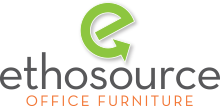The word ergonomics is thrown around the office world a lot. I’m sure you’ve heard it’s a very important part of an office’s productivity and overall health. So you take a look at your chair and think it’s pretty comfy, so you’re good right? But ergonomics is much more than the feel of your seat cushion or armrest. If you really want to benefit from ergonomics in the workplace, it’s important to know what exactly this all really means.
To start, the word broken down by the Greeks literally means “Work Laws” (Ergon= work, Nomos=Natural Laws) or, in other words, a science that is intended to describe the relationship between a person and their work. This science focuses on “describing the job to fit the worker, not forcing the worker to fit the job.”
To understand how ergonomics can help us in our everyday jobs, we need to know what aspects of the job could instigate health issues. Physical stressors are the cause of problems in the workplace because they involve repetitive motions that over time cause discomfort, such as typing or stroking a paintbrush. Other physical stressors involve vibration perhaps caused by power tools, or excessive force due to heavy lifting. More common physical stressors may be less obvious. Sitting in an awkward position if your chair doesn’t have the right support or if you’re constantly on the phone, also results in strain injuries that can affect your health and performance. It’s important to have furniture and equipment that caters to these unique, repetitive motions in order to decrease your chances of different injuries that could result down the road. And this is what ergonomics aims to do.
When we think of comfort it isn’t solely about how soft a seat feels when we sit in it, but it’s all aspects of how we feel including sight and hearing as well. Different environmental factors within an office building can also pose a threat to your health and productivity. Things such as air quality, excessive noise, or improper lighting can all go unnoticed until headaches, fatigue, or eyestrain start impacting your work. Here is where ergonomics have developed adjustable monitor arms to reduce glare, acoustic cubicle panels to reduce surrounding noise, or chairs that can be adjusted to support good posture and spare you unnecessary back or wrist pain reaching for your keyboard.
It’s important to understand the meaning of ergonomics in the workplace in order to know it’s not only beneficial for comfort, but also crucial for health. The duties we perform at work are a huge part of our everyday life and ignoring how these actions impact our body day in and day out will not only physically harm us overtime, but can influence whether you enjoy your job or not. Everyone wants an employee who is happy and productive and not one who is mentally and physically struggling everyday, and the ergonomics of the office could be the difference.
